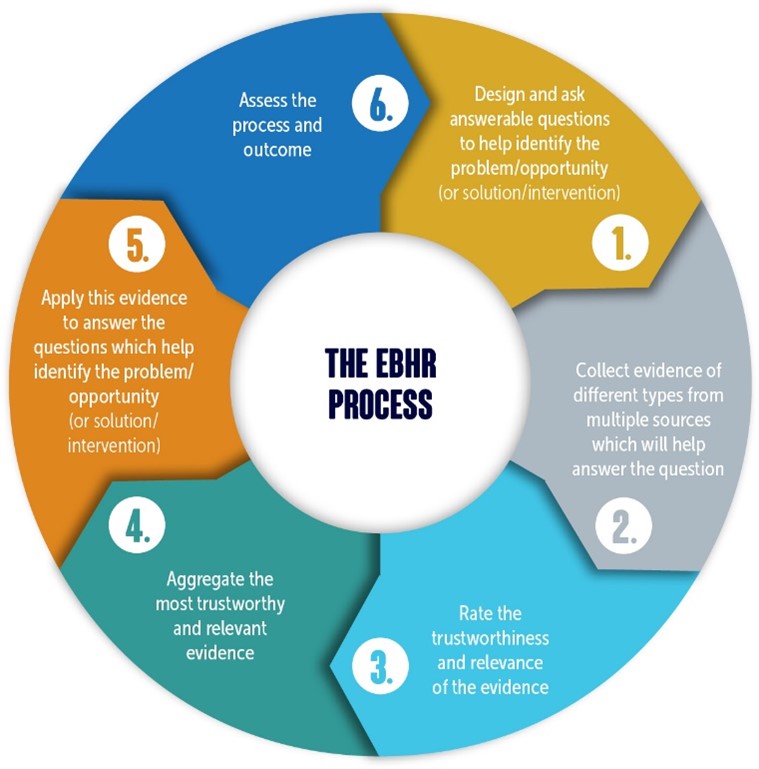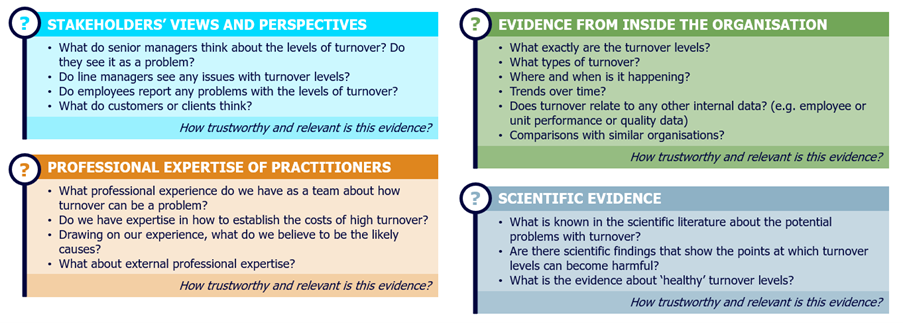Aligning HR with the business through the evidence-based HR process
- 7 Min Read
Rob Briner outlines the evidence-based HR process step-by-step. He works through the case study of understanding and solving high employee turnover using this evidence-based approach.
- Author: Rob Briner
- Date published: Oct 3, 2023
- Categories

What is evidence-based HR and why is it effective? Let’s start with a few basic questions.
- When you’re making a reasonably complicated and important decision, are you more likely to get the outcome you want if you systematically take account of relevant information or evidence?
- Are you even more likely to get the outcome you want if you ensure that the evidence you use is trustworthy or reliable?
- And, are would you even further increase your chances of getting the outcome you want if you use multiple sources and types of evidence rather than just one?
If you answered “yes” to these three questions then you already understand the principles of evidence-based practice.
But what exactly is evidence-based practice and how does it apply to HR?
What is evidence-based HR?
In Strong Foundations: Evidence-Based HR we define evidence-based HR as:
…a process which delivers better-informed and hence more accurate answers to two fundamental questions: First, which are the most important problems (or opportunities) facing the organisation which are relevant to HR activities? Second, which solutions (or interventions) are most likely to help? In other words, what’s going on and what can we do about it? These questions are answered through a combination of using the best available evidence and critical thinking.
One widespread criticism of HR is that too often it does not sufficiently align with what the business is trying to achieve. When this happens, even if there is plenty of HR activity, it will not add value.
Evidence-based HR tackles this issue directly by first gathering data on important problems (or opportunities) facing the organization not problems that are assumed to be relevant or important.
When, and only when, organizations understand the problems reasonably well can they follow a similar process to identify what is likely to be the most effective solutions.
Applying the main steps in evidence-based HR
As discussed, we all use evidence, but that’s not the same as taking an evidence-based approach that optimizes the way we use evidence.
Following this process to first identify possible problems (or opportunities) and, second, following the same process to identify solutions (or interventions to capitalize on opportunities) allows us to more systematically take into account the available evidence.

Looking at the main steps in evidence-based HR, the differences between just using evidence and evidence-based practice become clear.
1. Design and ask answerable questions to help identify the problem/opportunity (or solution/intervention): Don’t underestimate the importance of asking good questions. Spending time designing good questions that are in principle answerable is a vital starting point as is checking that the answers will be practically useful and relevant to organizational objectives.
2. Collect evidence of different types from multiple sources which will help answer the question: Consider at least four sources to check if they contain evidence that will help answer the question – stakeholders’ views, perspectives, and judgments; professional expertise of practitioners; data and evidence from the context or setting and scientific findings. We will discuss these sources further below.
3. Rate the trustworthiness and relevance of the evidence: Evidence quality and relevance can vary enormously. Making explicit judgments about both features means we avoid including evidence that is likely to be misleading and/or not apply to our context.
4. Aggregate the most trustworthy and relevant evidence: Rather than examining all the available evidence – much of which may be unreliable – we should use only the best available evidence.
5. Apply this evidence to answer the questions which help identify the problem/opportunity (or solution/intervention): What is the evidence suggesting? What is the answer (or what are the answers) to your question? How clear or confident are you in the answer?
6. Assess the process and outcome: Was there enough evidence? Was it accessible and usable? Did you use the evidence? What decisions did you eventually take? How did these relate to the evidence?
What does evidence-based HR look like in practice?
High levels of employee turnover are concerning to organizations. But how can we more accurately identify precisely what these turnover problems are and, should we find some, how can we more accurately identify potential solutions?
This example illustrates the types of questions we might ask when collecting data from each of the four sources first about the problem and then about the solution.
Identifying a problem

This example further demonstrates differences between how we might usually use evidence and how we use evidence from an evidence-based practice perspective. For example, we always use one source of evidence, but how often do we use two or even four? We always gather evidence, but how often do we explicitly evaluate its trustworthiness and relevance?
Understanding a solution
If (and only if) organizations identify a specific problem of high employee turnover, we can ask similar questions to identify possible solutions which are relevant to our specific turnover problem and our organizational context.

Often, people are initially concerned about the number of questions it’s possible to ask, that it may take more time and that it might be challenging to get hold of data and evidence to answer these questions.
These concerns are valid. However, if the problem is potentially very important to the business and solving it is highly beneficial to the business then it’s always worth investing time to develop a better understanding of what’s happening and what we can do about it. If the problem is likely to be trivial then this approach is not necessary.
And what about all the questions we can’t answer? This isn’t as much of a stumbling block as it might seem. We’re not trying to make a perfect decision but a better-informed decision. This means we don’t need every single piece of relevant data or evidence but, rather, we just need more than we had before.
There’s also a surprising advantage for any HR function when we discover there are important questions we currently can’t answer: Over time we can start to identify ways of ensuring that the next time the function needs to make better-informed decisions the data and evidence we need to answer those questions is more accessible.
Why is it so effective?
People sometimes ask if evidence-based HR is effective and if it’s worth doing. To answer this question let’s return to the three basic questions we asked at the start.
Yes. We are more likely to get the outcome we want if we systematically take account of relevant information. And, yes, we are even more likely to get the outcome we want if we make sure the evidence is trustworthy and relevant. And, yes, the we further increase the likelihood if we use multiple sources and types of evidence.
Evidence-based HR is effective as it enables the HR function to focus on these three principles and therefore make better-informed decisions which in turn helps HR to be better at helping the business.
________________
Rob Briner is the Professor of Organizational Psychology at, the School of Business and Management, Queen Mary University of London, and Associate Director of Research, at the Corporate Research Forum.









